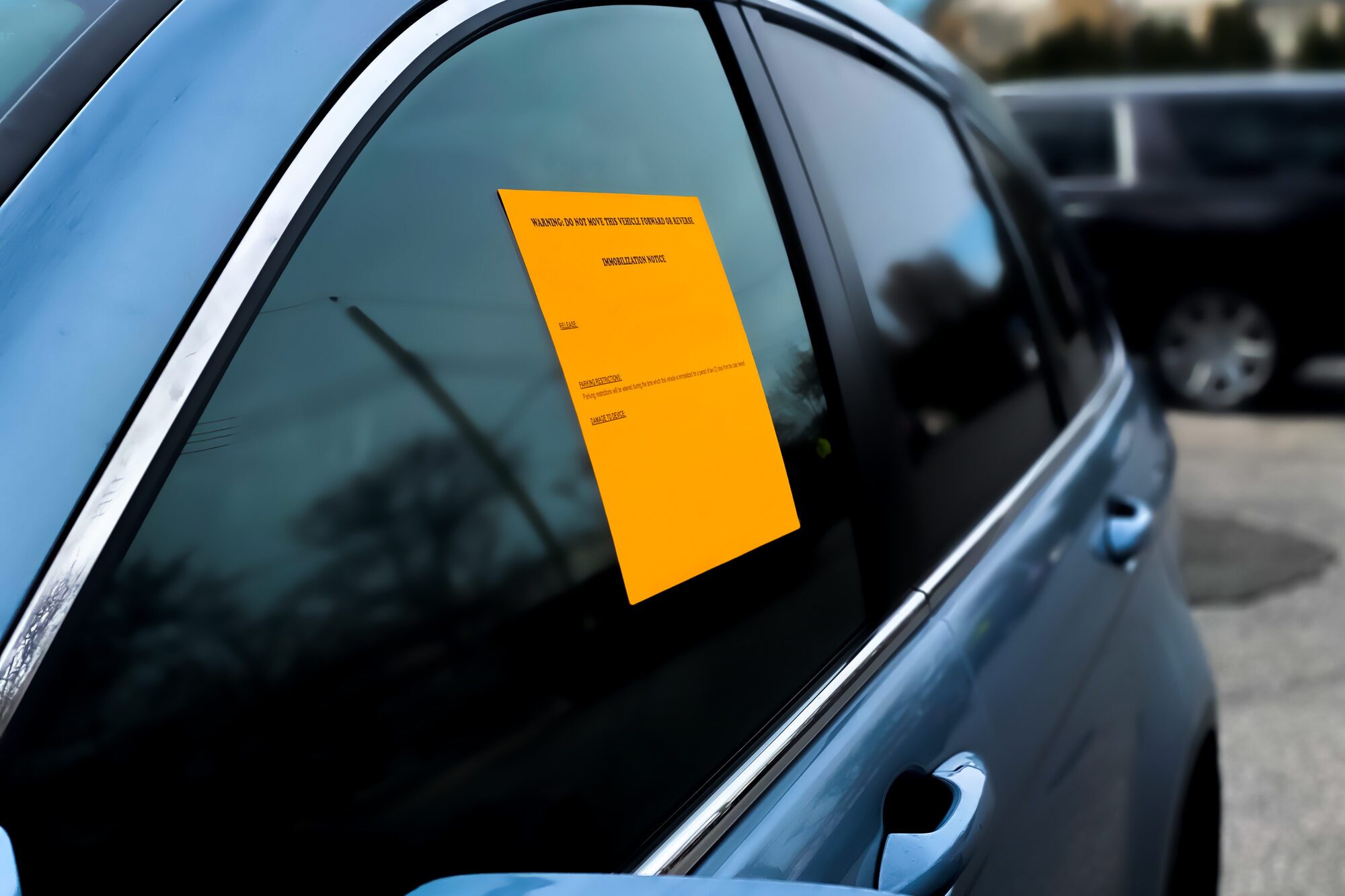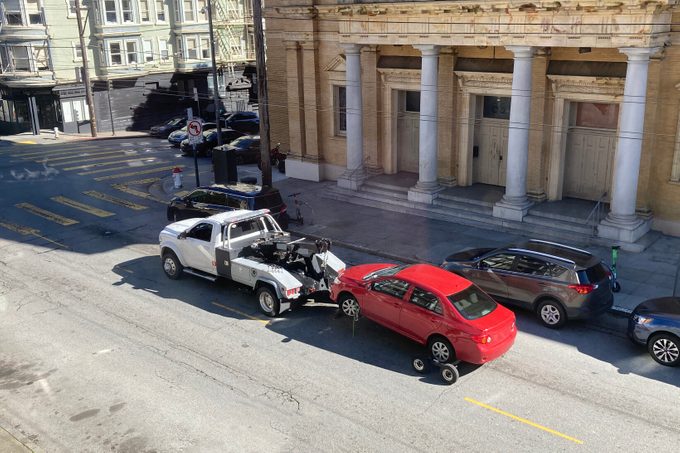What are these orange stickers, and what happens if you get one on your car? Nothing good, but we'll help you avoid the hassle.

If You See an Orange Sticker on a Car, This Is What It Means

We’ve all seen those lonely cars on the side of the highway. Maybe they’re up on a jack, or the fuel door is popped open with nary a human in sight. Sometimes, there’s a bright orange sticker slapped across the front windshield or rear window. Like most people, you probably give it a glance and keep driving. But what are these orange stickers on cars? And who puts them there?
I’ve actually gotten an orange tag on my car, so I can speak from experience about these stickers. But that was years ago, so to get the most current and official scoop on the subject, I talked to representatives from two city police departments and a safety and legal expert from the American Automobile Association (AAA).
Ahead, we’ll explain what these orange stickers on car windows are and what you should do if you’re unlucky enough to get one.
Get Reader’s Digest’s Read Up newsletter for more car news and tips, humor, travel, tech and fun facts all week long.
Who puts those orange stickers on cars?
Law enforcement puts them there, according to Senior Corporal Brian E. Martinez of the Dallas (Texas) Police Department and Jess Olstad, media relations coordinator, speaking on behalf of the Minneapolis (Minnesota) Police Department. Depending on where you live and where you left your car, law enforcement could mean state or local police, highway patrol, municipal parking officers or state inspection services.
“In Dallas, parking enforcement and/or the Dallas Police Department handles vehicles parked on public streets,” Martinez says, while the Texas Department of Public Safety handles vehicles on highways. Minneapolis operates similarly, with local traffic control officers ticketing cars parked on public streets, Olstad says. Your state and city likely have their own rules for enforcement.
What does it mean if there’s an orange sticker on a car?
I wondered the same, until I spent hours at the impound lot getting my car out of the impound. It depends on the jurisdiction, but most of the time those orange stickers on cars mean they’re about to get towed. In my house we now refer to these as the stickers of shame, but there’s no reason to be embarrassed. It can happen to anyone, right? Right.
Here’s why cars might get an orange sticker:
Abandonment
This is the most common reason officers place orange stickers on cars, with the definition of abandonment and the time frame for a vehicle to be considered abandoned varying by jurisdiction. Running out of gas and leaving your car temporarily is one thing, but if you fail to come back within a reasonable amount of time (determined by statute), your car will be considered abandoned.
Inoperable or unsightly vehicle
Cars that look like they can’t be driven away under their own power are candidates for orange stickers, too. “Any inoperable vehicle lacking vital component parts will also be considered abandoned and subject to ticketing and towing,” Olstad says.
You’re not necessarily in the clear if your car is on private property, either. “The City also has rules for vehicles parked outdoors on private property,” Olstad adds, specifically mentioning missing wheels or engines and broken windows as flags for law enforcement. “The inspector would also send a notice to the property owner with a deadline to fix or remove the vehicle.”
Parking violation
This is why I got the orange sticker on my car. It was an accident, I swear, but what can you do when you’re out of town? Stickers are placed as a courtesy, giving drivers like me a chance to rectify the situation. I didn’t actually see the orange sticker until I picked up my vehicle since my car had been towed before I returned to my parking spot, but it was there, like a giant neon flag. And it was hard to get the sticker off; those things are sticky.
Expired inspection sticker
In Minneapolis, “expired registrations may be tagged with a yellow sticker” on cars, Olstad says, but your city could use orange. You could also get a sticker if you have too many vehicles on your property. Olstad says Minneapolis city ordinance limits you to two vehicles parked on private residential property. Excess vehicles are considered a nuisance and could be towed even if they’re in your own yard.
How can law enforcement tell if a car has been abandoned?
Chalking tires is a common law enforcement tool to determine whether a car has been moved. It’s exactly what it sounds like: An officer makes a mark on your tire with a piece of chalk and notes the location of the mark (such as 6 o’clock). If the chalk line is in the same place after the officer comes back, it’s obvious that your car hasn’t moved since the time allotment ran out.
That’s what they do in my old hometown. “In Minneapolis, vehicles parked on public streets are considered abandoned if they are not moved after 72 consecutive hours,” Olstad says. After chalking the vehicle and leaving a courtesy notice, the officer comes back. “If it hasn’t been moved in that time, the vehicle will be ticketed and towed.”
What should you do if there’s an orange sticker on your car?
If you see an orange sticker, the first thing to do is move your car as soon as possible. Depending on when the sticker was put there, you may not have much time. In Dallas, you have 24 hours, beginning from the time the officer applies the sticker, Martinez says. As noted above, Minneapolis gives you 72 hours. Your municipality or state could have a different time frame.
After you’ve moved your car, follow up with the entity that applied the sticker and pay your fine, which will vary depending on the violation. The sticker will give you pertinent information, like a phone number to call or an address to send your payment. In Dallas, “the application of the sticker will be documented with a police report and a case number,” Martinez says.
What should you do if you see an orange sticker on someone else’s car?
Driver safety expert William Van Tassel, PhD, of AAA, says it’s always a good idea to give orange-stickered cars room if it’s safe to do so. Many drivers are aware of “slow down, move over” laws, Van Tassel says, which require you to change lanes or otherwise avoid “active scenarios” like a law enforcement vehicle or a driver working on a car by the side of the highway, and AAA encourages drivers to do the same for an abandoned car.
“The law may not require you to do that maneuver for a disabled, abandoned or apparently abandoned vehicle, but it’s still a good idea,” Van Tassel says. “Even if it has a sticker and looks abandoned, there might be someone there working on the car that you just can’t see.”
What will happen to your car if you don’t handle an orange sticker?

Ignoring or otherwise not handling an orange sticker will not turn out well for you, trust me. I think I paid over $500 by the time my self-inflicted ordeal was over. There’s the original ticket you’ll have to pay, plus the impound charges, most of which rack up by the day. If you really ignore the sticker, after another pre-determined time frame (possibly 30 days), your car could legally become the property of the city or state that towed it.
Check your local or state impound rules for more details.
What do other color stickers on a car mean?
You might think orange stickers on cars are the only way officers mark an abandoned, inoperable or poorly parked vehicle, but any bright color can be used, including red, yellow and green. Every parking enforcement jurisdiction has different sticker colors, but they generally convey the same thing: You need to move your car because it’s about to get towed. Trust me, that’s a lesson you don’t want to learn the hard way.
About the experts
|
Why trust us
At Reader’s Digest, we’re committed to producing high-quality content by writers with expertise and experience in their field in consultation with relevant, qualified experts. We rely on reputable primary sources, including government and professional organizations and academic institutions as well as our writers’ personal experiences where appropriate. For this piece, Ally Childress tapped her experience as a longtime journalist to ensure that all information is accurate and offers the best possible advice to readers. Read more about our team, our contributors and our editorial policies.
Sources:
- Brian E. Martinez, senior corporal with the Dallas Police Department; email interview, Feb. 11, 2025
- Jess Olstad, media relations coordinator for the City of Minneapolis; email interview, Feb. 19, 2025
- William Van Tassel, PhD, manager of driver training programs for AAA; phone interview, Feb. 13, 2025
- Dallas Police Department: “Auto Pound Unit”
- City of Minneapolis: “Parking & Vehicles”























